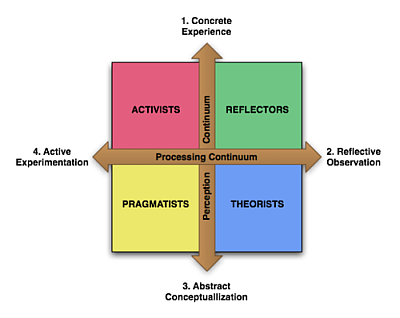 Improvement implies learning – new experiences, new insights, new models and new ways of doing things.
Improvement implies learning – new experiences, new insights, new models and new ways of doing things.
So understanding the process of learning is core to the science of improvement.
What many people do not fully appreciate is that we differ in the way we prefer to learn. These are habitual behaviours that we have acquired.
The diagram shows one model – the Honey and Mumford model that evolved from an earlier model described by Kolb.
One interesting feature of this diagram is the two dimensions – Perception and Processing which are essentially the same as the two core dimensions in the Myers-Briggs Type Index.
What the diagram above does not show so well is that the process of learning is a cycle – the clockwise direction in this diagram – Pragmatist then Activist then Reflector then Theorist and back to Pragmatist.
This is the PART sequence. And it can start at any point … ARTP, RTPA, TPAR.
We all use all of these learning styles – but we have a preference for some more than others – our preferred learning styles are our learning comfort zones.
The large observational studies conducted in the 1980’s using the PART model revealed that most people have moderate to strong preferences for only one or two of these styles. Less than 20% have a preference for three and very few feel equally comfortable with all four.
The commonest patterns are illustrated by the left and right sides of the diagram: the Pragmatist-Activist combination and the Reflector-Theorist combination.
It is not that one is better than the other … all four are synergistic and an effective and efficient learning process requires being comfortable with using all four in a continuous sequence.
Imagine this as a wheel – an imbalance between the four parts represents a distorted wheel. So when this learning wheel ‘turns’ it delivers an emotionally bumpy ‘ride’. Past experience of being pushed through this pain-and-gain process will tend to inhibit or even block learning completely.
So to get a more comfortable learning journey we first need to balance our PART wheel – and that implies knowing what our preferred styles are and then developing the learning styles that we use least to build our competence and confidence with them. And that is possible because these are learned habits. With guidance, focus and practice we can all strengthen our less favoured learning ‘muscles’.
Those with a preference for planning-and-doing would focus on developing their reflection and then their abstraction skills. For example by monitoring the effects of their actions in reality and using that evidence to challenge their underlying assumptions and to generate new ‘theories’ for pragmatic experimentation. Actively seeking balanced feedback and reflecting on it is one way to do that.
Those with a preference for studying-and-abstracting would focus on developing their design and then their delivery skills and become more comfortable with experimenting to test their rhetoric against reality. Actively seeking opportunities to learn-by-doing is one way.
And by creating the context for individuals to become more productive self-learners we can see how learning organisations will follow naturally. And that is what we need to deliver system-wide improvement at scale and pace.
